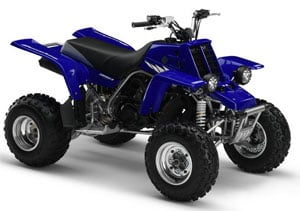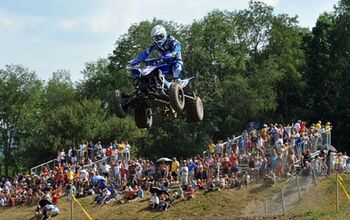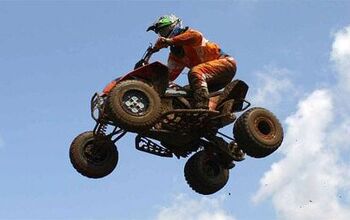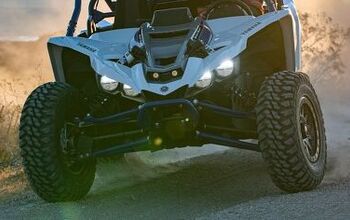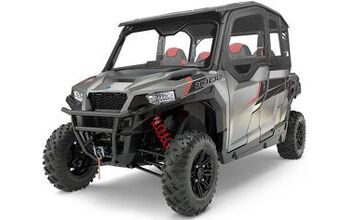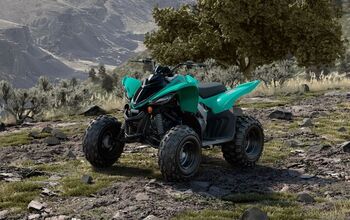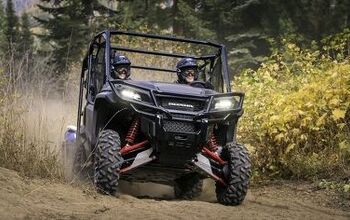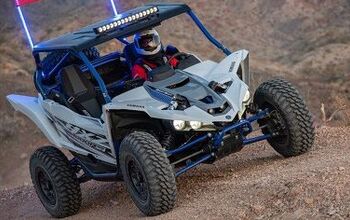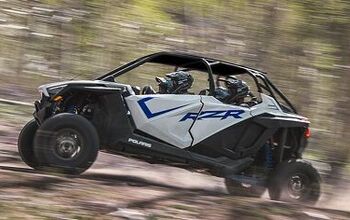Where Have All The Sport ATVs Gone?
A quick look at the modern ATV landscape reveals quite a different picture than just a few short years ago. Before the economic crisis took a strong hold, seven manufacturers offered ‘race-ready’ 450cc Sport ATVs – most of which were new or recently updated. Since the 2009 model year only two manufacturers have even offered an updated model and several others have seemingly abandoned the class entirely.
While it may appear that the very future of this class is on shaky ground, we’re not quite that pessimistic. But before we look at what the future may hold, it makes sense to look at the recent history of Sport ATVs to see what we can learn.
In The Beginning
The Yamaha Banshee was one of the few Sport ATVs in production in the 1990s.
The Sport ATV segment has seen more ups and downs in recent years than opening day at a Six Flags amusement park. After the factories pulled out of ATV racing the first time, most of the 1990s were spent in limbo as only a few Sport models like Yamaha’s Banshee and Warrior along with Honda’s 300EX remained in production.
Honda began breathing life into the Sport ATV segment with the introduction of the Sportrax 400EX, the first new sport model introduced in almost a decade. Suzuki followed suit a few years later with the QuadSport Z400, which sparked the return of factory involvement to ATV racing and launched an all out war on the high performance Sport ATV segment.
Fast forward a few more years and we see seven manufacturers offering 450 class Sport machines, several of which were offered in multiple configurations and additional displacements.
Along the way a handful of manufacturers dabbled in the big bore Sport ATV market, releasing innovative V-Twin and Independent Rear Suspension models only to have them disappear about as quickly as they came onto the market.
Sport ATVs with independent rear suspension, like the Honda TRX700XX, came and went fairly quickly.
Today the Sport segment is somewhat of a question mark. Every manufacturer seems to have a different perspective on this rather stagnate portion of the industry. Some OEMs remain heavily involved while others appear to be pulling out to focus on other segments. What do some manufacturers see that others don’t? We had the opportunity to speak with representatives from several manufacturers as well as a couple of reputable aftermarket companies that have been in business through the good and the bad to get their perspective on the ever unpredictable Sport ATV segment.
The Return
Honda gave the Sport ATV segment a much-needed kick in the pants with the release of the Sportrax 400EX in 1998.
It seems safe to say that Honda can be credited with jump starting the Sport segment that spent most of the 90s in limbo with the release of its Sportrax 400EX. Several manufacturers followed suit, including Suzuki and Kawasaki who had a technology sharing agreement that resulted in Suzuki’s Z400 and Kawasaki’s KFX400. Kawasaki discontinued the KFX400 in 2006, while Suzuki continues to produce the Z400 today.
Yamaha also entered the ring in 2001 with the release of the Raptor 660. The Raptor has undergone several transformations over the years and remains one of the best selling Sport ATVs on the market, not to mention the last remaining big bore Sport ATV.
The Golden Years
KTM took “race ready” to a whole new level with its family of short lived Sport ATVs.
2004-2008 saw a mad rush between the OEMs to release machines and capture market share in the growing 450cc class. Yamaha and Honda were the first in the game then along came Suzuki with its extremely competitive, fuel injected LT-R450. Kawasaki, Polaris, KTM and Can-Am each came along later with several machines boasting ‘race ready’ performance right from the factory. KTM probably wins the award for being the most race ready as the Austrian manufacturer offered its 450, 505 and 525 models with long travel suspension, hydraulic clutches and a laundry list of other goodies.
By 2008 the racing scene was buzzing with seven manufacturers fielding factory racing programs in at least one or more major ATV racing series. Top racers could make a pretty healthy living and manufacturers were producing Sport ATVs in record numbers. That same year the financial crisis hit and began taking its toll on the economy and the Sport ATV market as a whole, forcing everyone to scale back and many OEMs to pull out of the segment completely.
Polaris’ Outlaw lineup did not survive the financial crisis.
“In 2008, the Financial Crisis hit, and the Sport ATV segment was one of the powersports segments that was hardest hit in terms of a reduction in demand for new unit sales, especially for the high performance racing ATVs that KTM produced,” says KTM’s Product Line Manager John Hinz.
KTM dropped its Sport ATV line completely, but it wasn’t the only one. Polaris stopped production on its Outlaw line of Sport ATVs and began concentrating its efforts on its Utility and Side by Side programs. Suzuki also stopped production of the QuadRacer LT-R450, although not solely due to decreased demand. Suzuki ran into an emissions issue with the EPA and have only recently reached a settlement. For now Suzuki’s sole Sport ATV is the QuadSport Z400, but we have high hopes that we’ll see the return of the LT-R450 or perhaps a new 450 class ATV from Suzuki in the not too distant future.
Present
We took this Suzuki QuadRacer LT-R450 outfitted with Yoshimura and Pro Armor goodies and took it GNCC racing in 2009.
Today the bulk of the remaining Sport ATVs in production are receiving little if any attention by way of upgrades or new technology. Mark Baldwin, owner of Baldwin Motorsports and mechanic for top racers of the past and present, calls it BNG or “Bold New Graphics.” While our two-wheeled friends seem to be getting yearly updates and advancements in technology, most of the remaining Sport ATVs seem to be lucky to get new graphics and a different colored frame.
On the aftermarket side, companies are seeking out new ways to diversify and remain competitive in an unstable climate. One company that’s thriving amidst a sea of businesses struggling to keep their doors open is Pro Armor, makers of performance ATV and Side-by-Side accessories.
“Overall, the company has grown by 50 percent a year for the last two years” says Sales and Marketing Manager Fred Brayton. While much of that growth is attributed to its involvement in the Side by Side market, Pro Armor hasn’t forgotten its roots in the ATV industry and continues to produce innovative products for Sport ATV enthusiasts. “We just released a new ATV bumper as well as billet aluminum sprocket and rotor guards for Sport ATVs,” says Brayton. “R&D is the lifeblood of the company; you’re only as good as your last product.”
Despite the struggling economy, BRP’s Can-Am brand has remained a strong supporter of ATV racing.
It’s not all doom and gloom for the Sport ATV segment, however, as Yamaha and Can-Am have both proven their commitment to the segment as well as the ATV racing community. Can-Am burst onto the racing scene in 2008 with the release of its DS 450 Sport ATV. Despite the economic crunch, Can-Am has maintained its support of the ATV racing community at both the national and local level by offering the largest contingency program in the history of the sport. “Racing is very important to BRP,” says Can-Am’s Media and Public Relations Manager Chaz Rice. “[the contingency program] is our way of giving back to ATV racers that choose to use Can-Am.”
The Canadian manufacturer has also shown commitment to Sport Utility and big bore users with its popular Renegade ATV. According to Rice, although Can-Am halted production of its DS 650 with the release of the 450 model, it has since found the Renegade delivers what the 650 consumer wanted.
Yamaha reintroduced the venerable YFZ450 for the 2012 model year with a much lower price tag than its race-ready YFZ450R.
It’s arguable that the manufacturer that has shown the greatest commitment to the Sport ATV segment over the last 25 years is Yamaha. Not only did Yamaha continue production of Sport ATVs through the lull of the 90s, but it has since introduced several completely new models and its old ones have received some tremendous upgrades. While the Banshee and Blaster have since gone away, Yamaha has made significant improvements to both its YFZ450 and Raptor Sport ATVs.
Yamaha has also introduced new Youth or entry-level models. According to Yamaha’s Marketing Manger Steve Nessl, these new models are a means of growing new enthusiasts and making them lifelong fans of the Yamaha brand. Throughout our conversation, Nessl stressed Yamaha’s unwavering commitment to the Sport ATV segment and that commitment has shown in recent years with the release of more affordable versions of both the YFZ450 and Yamaha Raptor 700.
After introducing the redesigned and fuel injected YFZ450R in 2009, Yamaha re-released the original YFZ450 as a cost-effective option in 2012. While it lacks the EFI and piggyback reservoir shocks of the 450R model, it allows consumers on a tighter budget the same opportunity to get out and ride. The same can be said of the Raptor 700, which we tested back in June. With three options to choose from, every model actually decreased in price over the previous year proving that Yamaha remains committed to the Sport ATV segment despite the trying economic times.
For 2013 Yamaha offers the Raptor 700 in multiple price points, each more affordable than in prior years.
Future
While the future of Sport ATVs is looking a little bleak, we are a long ways from the high and dry times of the 1990s. Even as the economy continues its struggles, several OEMs continue to support racing at various levels and the premier racing class still has four manufacturers with models in production.
Though Sport ATVs aren’t nearly as popular as they once were, several OEMs continue to support racing efforts. Hopefully this will help to make the sport attractive for future generations.
We’ll keep our fingers crossed for an upswing in the economy and hopefully that will give the Sport segment some new life by way of new and improved Sport ATV models.
Related Reading
Growing up in Oregon, most of Seth's involvement in the powersports world was limited to what he saw in magazines and videos. Following a brief stint in the corporate world, Seth took a flying leap (literally) and moved to California to pursue a career in freestyle motocross. Though short lived, the opportunity immersed him in the industry and is now a well-established off-road writer.
More by Seth Fargher



